Lefebvre A.H., Ballal D.R. Gas Turbine Combustion: Alternative Fuels and Emissions
Подождите немного. Документ загружается.


490 Gas Turbine Combustion: Alternative Fuels and Emissions, Third Edition
physical properties, such as viscosity, bulk modulus, specic heat, and ther-
mal conductivity, were typical of conventional jet fuels.
Harrison and Zabarnick [60] performed the thermal stability analysis
and Figure 10.21 shows the results using a quartz crystal microbalance. The
dynamic viscosity of conventional and synthetic fuels at low temperature is
shown in Figure 10.22. Finally, the volume elastomer swell for nitrile rubber
o-rings (Parker N-602-214) was also measured and plotted in Figure 10.23.
Table 10.7 shows the properties of bio-based synthetic parafnic kerosine.
Essentially, the properties of HRJ biofuels are indistinguishable from FT
synthetic parafnic kerosine. Therefore, the blending issues for HRJ (50/50)
biofuels are also similar, namely, density, aromatic content, and GHG footprint.
At present, not much information is available on the t-for- purpose proper-
ties (lubricity, dielectric strength, cetane number), combustion operability
and emissions, material compatibility, and blending issues.
Goodger [1] has plotted composite plots of the fuel properties of conven-
tional fuels, biofuels, and alcohols. Figure 10.24 shows fuel density and
Figure 10.25 shows kinematic viscosity as a function of fuel temperature.
Finally, Figure 10.26 shows the variation of net specic energy with fuel
density.
10.9.4 Combustion and emissions Performance
10.9.4.1 Fischer–Tropsch Fuels
Moses and Roets [59] report engine and combustor performance tests as
follows:
Engine endurance•
Low-temperature atomization•
TABLe 10.6
Properties of Conventional JP-8, Synthetic FT, and JP-8/FT (50/50) Blend Fuels
Property JP-8 Min JP-8 Max FT
a
(100%) FT
a
/JP-8 (50/50)
Aromatics (vol %) -- 25.0 0.0 6.8
Total sulfur (wt%) -- 0.30 0.0 0.046
Flash point (°C) 38.0 -- 45.0 55.0
Freeze point (°C) --- –47.0 –51.0 –50.0
Viscosity at –20°C (cSt) -- 8.0 4.9 4.8
Heat of comb (Btu/lb) 18,400 -- 18,978 18,686
Hydrogen content (wt%) 13.4 -- 15.4 14.6
Density (kg/L at 15C) 0.775 0.840 0.756 0.781
JP-8 specication update
Note: Denition to include coal, biomass, and natural gas via Fischer–Tropsch; -- blend
instructions for petroleum and nonpetroleum; -- reference MIL-handbook for “t-
for-purpose” properties. Effect of these property nonconformities under evaluation.
a
Syntroleum synthetic JP-8 (S-8).
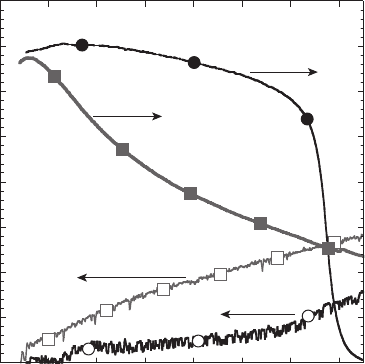
Alternative Fuels 491
Cold-day ignition and altitude relight•
Lean blowout•
Exhaust emissions•
The engine endurance, atomization and ignition tests showed no signicant
differences between the performance limits of fully synthetic jet fuels (FSJF)
and Jet A-1 fuels.
As shown in Figure 10.27, the Sasol FSJF had no adverse effect on lean
blowout limit. At higher altitudes, some limited fuel effects were noted, with
FSJF between the Jet A and JP-5 results. Since the lean blowout is considered
to be evaporation-limited, this result may be due to differences in boiling
point distribution of the two fuels and not due to fuel chemistry.
When an engine is certied, it must meet emissions standards recom-
mended by ICAO/CAEP (www.icao.org). Figures 10.28 through 10.30 show
the results of NO
x
, CO, and smoke number (SN), respectively. In the LTO
cycle, the Sasol synthetic fuel produced 4% less NO
x
and 19% less CO. These
emissions levels for both fuels were lower than the limits for CAEP/6. At all
other test conditions, the NO
x
emissions were unchanged and the CO emis-
sions were lower than that for the conventional fuel, presumably due to the
lower viscosity and ner spray produced by the Sasol fuel. The differences in
CO
2
and combustion efciency were found to be negligible.
0
1
2
3
4
5
6
7
8
0
5
10
15
20
25
30
35
40
02468101214
Mass accumulation (µg/cm
2
)
Headspace oxygen (%)
Time (hours)
Figure 10.21
Quartz crystal microbalance (QCM) deposition at 140°C (open markers) and oxygen proles
(lled markers) for a JP-8 fuel () and synthetic syntroleum S-8 fuel (•). (From Harrison, W.E.
and Zabarnick, S., Presented at DoE Clean Coal Conference, Clearwater, FL, 2007.)
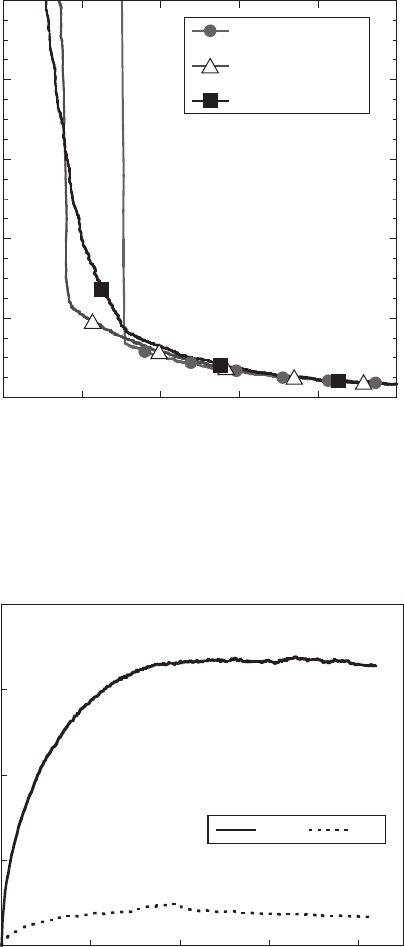
492 Gas Turbine Combustion: Alternative Fuels and Emissions, Third Edition
0
20
40
60
80
100
–70 –60 –50 –40 –30 –20
JP-8 (POSF-3773)
S-8 (POSF-4734)
S-8 (POSF-4820)
Dynamic viscosity (cP)
Temperature (C)
Figure 10.22
Dynamic viscosities of two synthetic (S-8) fuels compared with JP-8 fuel. (From Harrison, W.E.
and Zabarnick, S., Presented at DoE Clean Coal Conference, Clearwater, FL, 2007.)
0
5
10
15
20
04080120 160
JP-8 S-8
Volume swell (%)
Exposure time (hrs)
Figure 10.23
Volume swell vs. time for nitrile rubber o-ring samples. (From Harrison, W.E. and Zabarnick, S.,
Presented at DoE Clean Coal Conference, Clearwater, FL, 2007.)

Alternative Fuels 493
TABLe 10.7
Properties of Bio-Based Synthetic Parafnic Kerosine Fuels
Property SPK
ASTM Test
Method
Composition
Jatropha Coconut
Soybean/
Canola Soybean Palm
Parafn (vol%) Min 99.8 D2425
Cycloparafn (vol%) Max 5 D2425
Parafn (vol%)
a
Difference from
D 1319
99.3 99.5 99.5 100 98.4
1. Aromatics (vol%) Max 0.05 D 1319 0 0 0 0 0.8
2. Aromatics (vol%) Max 0.053 D 6379 0 0 0 0 0.8
Sulfur (total max %) Max 0.015 D 1266, D 2622,
D 4294, or D5453
0.00009 0.0003 0.001 0.0008
< 0.0001
1. Physical distillation D86
Distillation temp (°C)
10% recovered (temp (T10)) Max 205 172 188 189 186 197
50% recovered (temp (T50)) Report 192 200 214 226 236
90% recovered (temp (T90)) Report 223 231 248 280 254
Final boiling point (temp) Max 300 243 263 261 286 259
T90–T10 (°C) Min 25 51 43 59 94 57
Distillation residue (%) Max 1.5 1.2 1.3 1.2 1.4 1.2
Distillation loss (%) Max 1.5 0.4 0.5 0.8 1.0 0.7
2. Simulated distillation D 2887
Distillation temp (°C)
10% recovered (temp) Max 185 151.6 162 168 166.8 169
50% recovered (temp) Report 195 190.8 218.6 226.6 249
(Continued)

494 Gas Turbine Combustion: Alternative Fuels and Emissions, Third Edition
TABLe 10.7
Properties of Bio-Based Synthetic Parafnic Kerosine Fuels (Continued)
Property SPK
ASTM Test
Method
Composition
Jatropha Coconut
Soybean/
Canola Soybean Palm
90% recovered (temp) Report 237.6 238 267.2 297 269
Final boiling point (temp) Max 340 273.8 299 284.4 310.6 280
Flash point (°C) Min 38 D 56 or D 3828 50 64 62 60 64
Density at 15°C (kg/m
3
) 751–840 D 1298 or D 4052 751 755 763 766 769
Fluidity
Freezing point (°C) Max –47 Jet A-1 D 5872, D 7153,
D 7154, or D 2386
–63 –56 –52 –36 –44
Viscosity –20°C (mm
2
/s) Max 8.0 D 445
Combustion
Net heat of combustion (MJ/
kg)
Min 42.8 D 4529, D 3338, or
D 4809
44.4 44.2 43.5 43.8 44.2
Metal content D 7111
Copper (ppb) Max 100
< 0.01 ppm < 0.01 ppm < 0.01 ppm < 0.03 ppm < 0.02 ppm
Iron (ppb) Max 100
< 0.01 ppm < 0.01 ppm
0.04 ppm
< 0.03 ppm
0.02 ppm
Zinc (ppb) Max 100
< 0.01 ppm < 0.01 ppm < 0.01 ppm < 0.03 ppm < 0.02 ppm
Vanadium (ppb) Max 100
< 0.01 ppm < 0.01 ppm < 0.01 ppm < 0.03 ppm < 0.02 ppm
Thermal stability
JFTOT (2.5 h at control temp
of 280°C min)
Filter pressure drop (mmHg) Max 25 D 3241
< 0.1
25 0 0.0
Tube deposits less than 3
< 1 < 1
1
< 1
Source: From J. Holmgren, Private Communication, reproduced with permission, November 2008.
a
Balance of composition is olens.
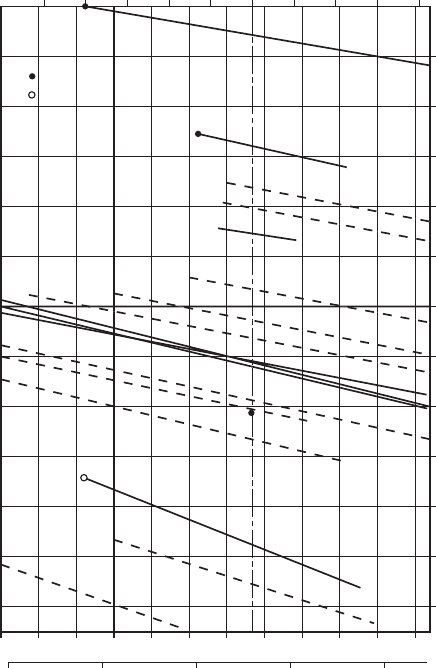
Alternative Fuels 495
Figure 10.30 shows that the Sasol synthetic fuel produced lower smoke than
the Jet A fuel as expected because of its lower aromatic content. Harrison and
Zabarnick [60] have reported emissions from FT fuels using the T63-A-700
turboshaft engine. Figure 10.31 shows the percent change in particulate num-
ber density (PND) with percent volume of synthetic FT jet fuel in JP-8 for
cruise and idle conditions. These results demonstrate reduced (smoke) par-
ticulate emissions on addition of the synthetic fuel. Clearly, this reduction
is attributed largely to the reduced aromatic concentration in the resultant
fuel blend. Reduction of the aromatics decreases the concentration of “seed”
–40 0
Temperature °F
40 80 120
1.1
1.0
0.9
0.8
Density kg/L
0.7
0.6
0
–50 –30 –10 10 30 50 °C
225 250 275
Temperature
300325
K
Key
Freezing point
Nitromethane
Hydrazine
RFO (G)
RFO (F)
Sunflower oil
Diesel fuel
Gas oil
Avcat
Methanol
MTBE
Mogas
Avgas
Ammonia
Comml. butane (l)
Comml. propane (l)
Avtag
Ethanol
Avtur
Boiling point
Figure 10.24
Fuel density vs. fuel temperature for conventional, bio, and alcohol fuels. (From Goodger, E.M.,
Transport Fuels Technology, Landfall Press, Norwich, UK, 2000. With permission.)
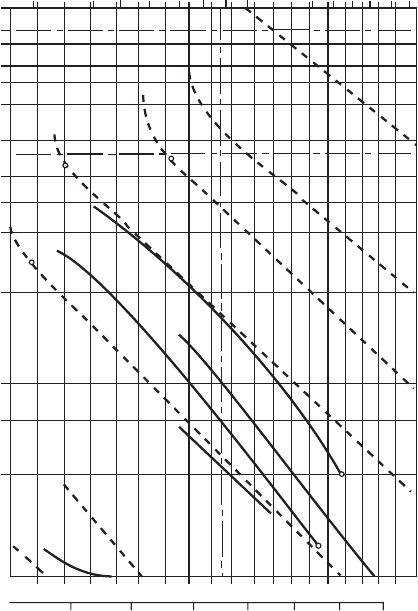
496 Gas Turbine Combustion: Alternative Fuels and Emissions, Third Edition
molecules that contribute to the formation of soot nuclei, thereby decreasing
the production of ne soot particulate. Thus, blending with FT fuel signi-
cantly reduces the mean diameter of the particulate exhaust.
Lieuwen et al. [61] reviewed the impact of fuel composition on the oper-
ability of lean premixed gas turbine combustors. These workers investigated
fuel blends of CH
4
/H
2
(LNG), CH
4
/CO
2
(landll gas), and CO/H
2
/N
2
(syn-
gas). They concluded that the behavior of fuel mixtures can be markedly
different than that of individual constituents. Moreover, properties such as
turbulent burning velocity and ignition delay time may behave in a highly
nonlinear fashion as fuel mixture changes.
–80
–40 0
40
80
120
150
200
ULP
ULA
3000
1000
500
200
100
50
20
10
6
4
2
1
0.8
2.6
0.4
–60
–40
–20
0
20
40
60
80
100
°C
250 300
350
K
Temperature
Propane
Ammonia
Butane
bp
Hydrazine
bp
Kerosene
Gas oil
Diesel fuel
Sunflower oil
cp
PP
PP
PP
cp
cp
Methanol
Ethanol
Gasoline
Kinematic viscosity, cSt
Temperature °F
Residual
fuel oil
(G)
Nitromethane
Figure 10.25
Kinematic viscosity vs. fuel temperature for conventional, bio, and alcohol fuels. (From
Goodger, E.M., Transport Fuels Technology, Landfall Press, Norwich, UK, 2000. With
permission.)
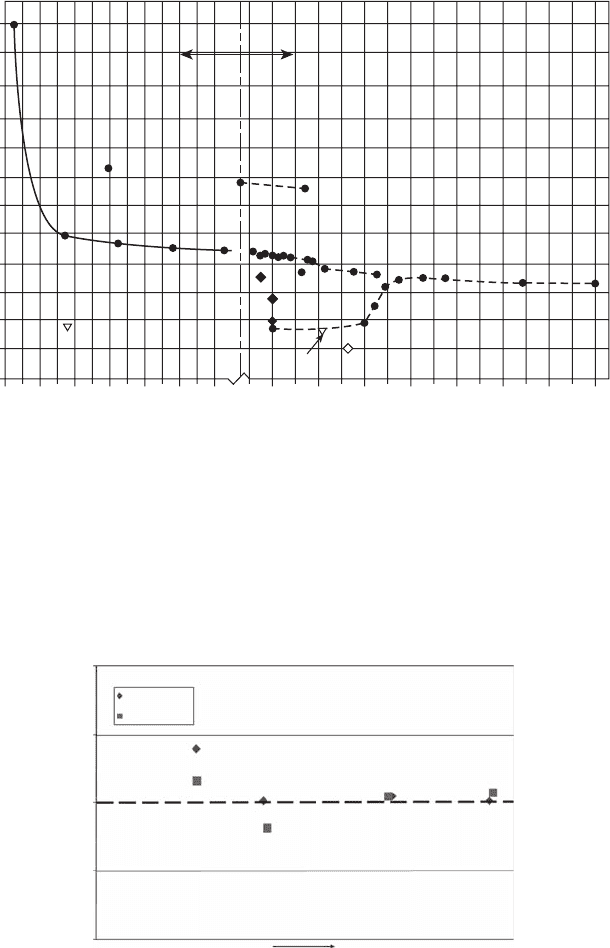
Alternative Fuels 497
0
0
20
40
60
80
100
Specific energy MJ/kg net
120
0.4 0.8 1.2
kg/m
3
kg/L
Fuel density at 15 °C
Hydrazine
Nitromethane
Peat
Lignite
Sunflower
oil
Petroleum
fuels
Decaborane
CTF
Wood
Methanol
Ethanol
MTBE
Butane
Propane
Ethane
Ammonia
Methane
Diborane
Pentaborance
Liquics and solicsGases
Hydrogen
Anthracite
Coals
Coke
Graphite
1.6 2.0 2.4 0.8 1.0 1.2 1.4 1.6 0.8 2.0 2.2
Figure 10.26
Specic energy vs. fuel density for conventional, bio, and alcohol fuels. (From Goodger, E.M.,
Transport Fuels Technology, Landfall Press, Norwich, UK, 2000. With permission.)
1.2
JP-5
Sasol FSJF
1.1
1.0
0.9
0.8
Increasing airflow
Relative F/A at lean blowout
Figure 10.27
Lean blowout limits for JP-8 and Sasol fully synthetic jet fuel (FSJF). (From Moses, C. and
Roets, P., ASME Journal of Engineering for Gas Turbines Power, 131, 4, 2009. With permission.)
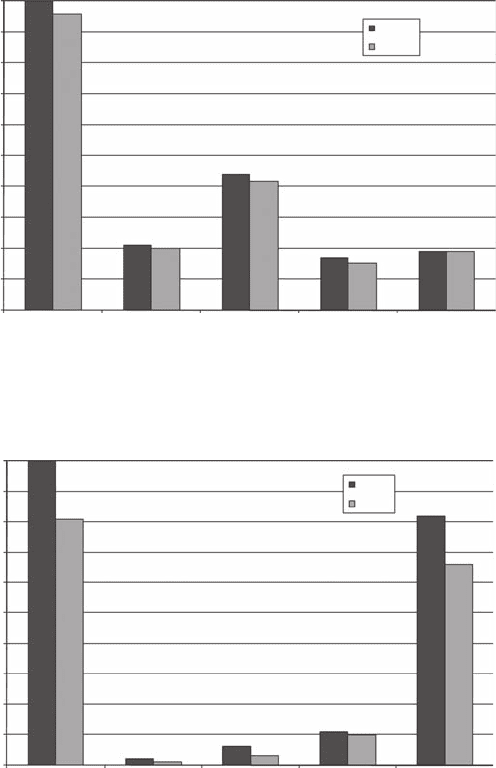
498 Gas Turbine Combustion: Alternative Fuels and Emissions, Third Edition
10.9.4.2 Biodiesel Fuels
Recently, researchers [62,63] have analyzed the inuence of biodiesel fuel on
combustor blowout, ashback, auto-ignition, and combustion stability.
Panchasara et al. [62] studied the combustion performance of biodiesel and
diesel–VO blends in a simulated gas turbine combustor. These experiments
were performed at atmospheric pressure with air-assist injector and swirling
100
90
80
70
60
% of NOx EPAP for petroleum-derived jet A
50
40
30
20
10
0
LTO SLTO Climb
Engine operating mode
Jet A
FSJF
Approach Idle
Figure 10.28
Comparison of NO
x
production for Jet A and fully synthetic jet fuel. (From Moses, C. and
Roets, P., ASME Journal of Engineering for Gas Turbines Power, 131, 4, 2009. With permission.)
100
90
80
70
60
% of CO EPAP for petroleum-derived jet A
50
40
30
20
10
0
LTO SLTO Climb
Engine operating mode
Jet A
FSJF
Approach Idle
Figure 10.29
Comparison of CO production for Jet A and fully synthetic jet fuel. (From Moses, C. and
Roets, P., ASME Journal of Engineering for Gas Turbines Power, 131, 4, 2009. With permission.)
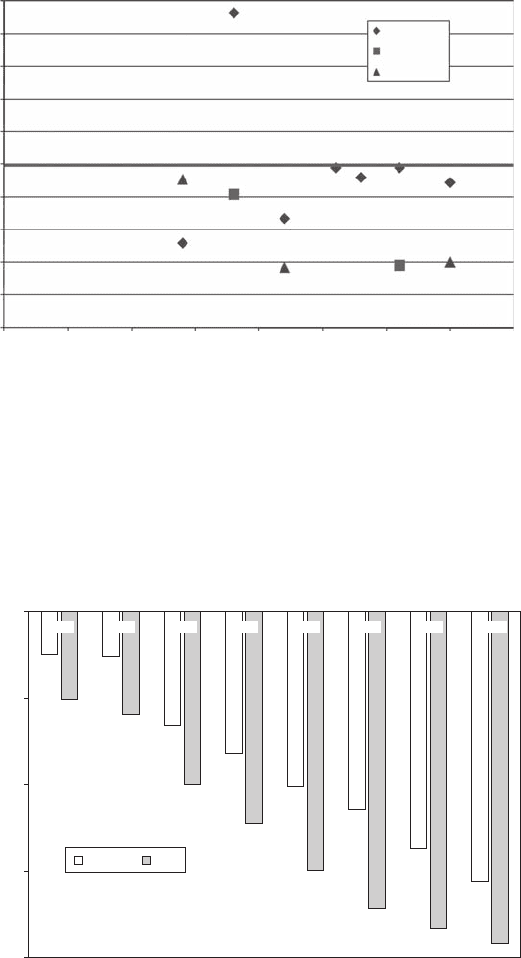
Alternative Fuels 499
2
1.8
1.6
1.4
1.2
SN Sasol / SN jet A
1
0.8
0.6
0.4
0.2
0
0 0.005 0.01 0.015 0.02
Overall fuel-air ratio
0.025 0.03 0.035 0.04
SLTO
Cruise
Approach
Figure 10.30
Comparison of smoke number for Jet A and fully synthetic jet fuel. (From Moses, C. and
Roets, P., ASME Journal of Engineering for Gas Turbines Power, 131, 4, 2009. With permission.)
–12%
–13%
–33%
–41%
–57%
–68%
–78%
–25%
–30%
–50%
–61%
–75%
–86%
–92%
–51%
–96%
–100%
–75%
–50%
–25%
0%
12.5% 25.0% 37.5% 50.0% 62.5% 75.0% 87.5% 100.0%
% volume of synjet fuel in JP-8
% change in particle number density
Cruise Idle
Figure 10.31
Reductions in particle number density emissions in T63 turbine engine as a function of the
concentration of the FT fuel in JP-8 blends. (From Harrison, W.E. and Zabarnick, S., Presented
at DoE Clean Coal Conference, Clearwater, FL, 2007.)
